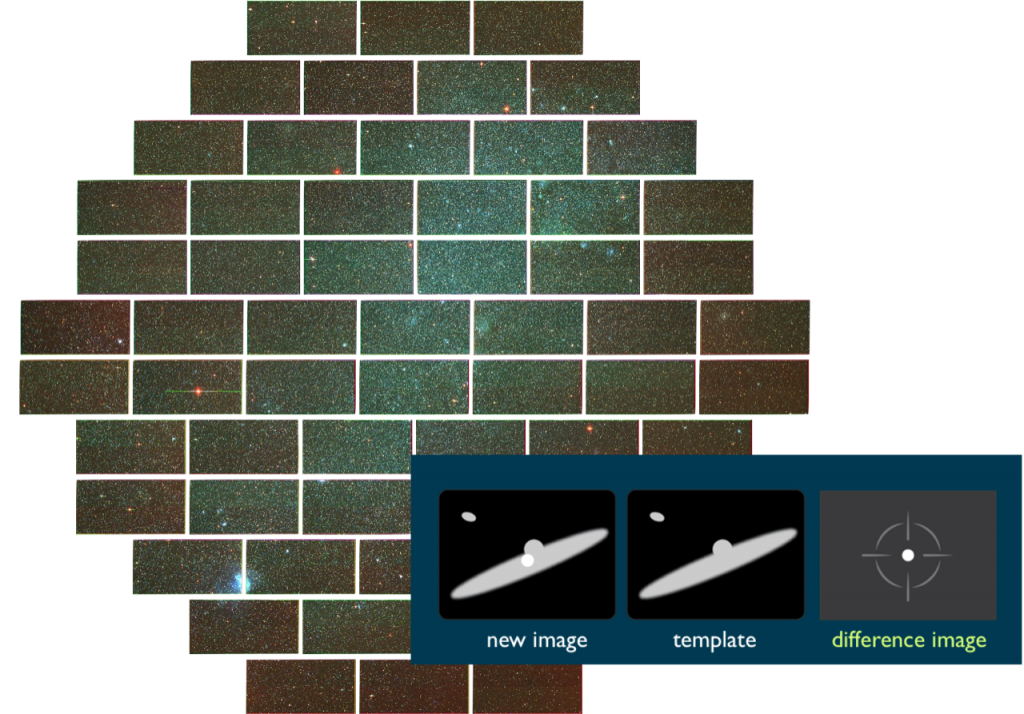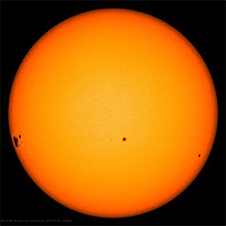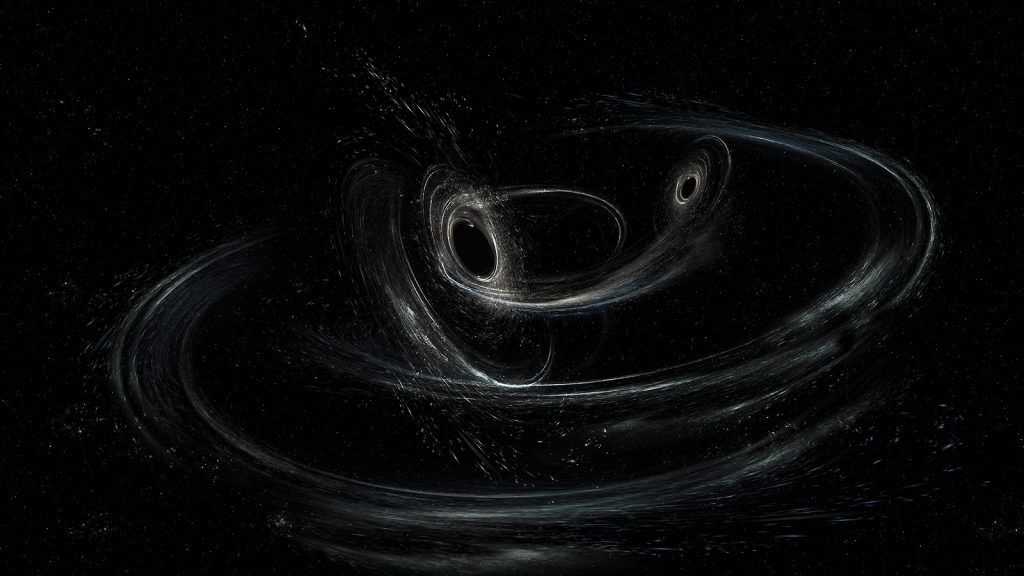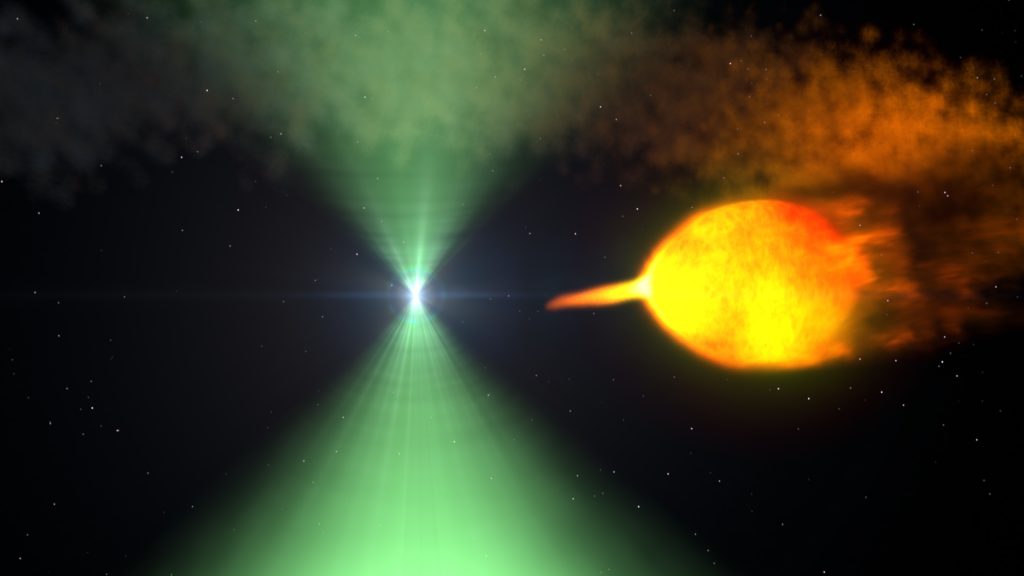Roughly half of the coursework in Pre-MAP will be spent working on a research project in a very small group with mentors from the Astronomy Department, a graduate student, postdoctoral fellow, or faculty advisor. The research projects typically advance the research goals of your mentor, and so the projects that we offer cover a variety of topics and size-scales from stars to galaxies.
Students can select their top three project choices, and we will sort you into groups among your top choices. Read about the projects below, and follow the links to learn about your potential advisors.
Title: New software, old data, and things that go bump in the night
Mentor: Meredith Rawls
Students: Courtney Hooks, Thomas Waters
Skills: python, jupyter notebooks, matplotlib, basic pandas, basic SQL queries

Lots of stuff changes in the sky every night: supernovae, variable stars, asteroids, and more! It’s impossible to find everything by manually looking at a zillion images, so instead we build software to carefully subtract two images and detect what is left over. In this project, you’ll use a new software pipeline for the upcoming Large Synoptic Survey Telescope (LSST) to find changing things in images taken with the Dark Energy Camera, which is kind of like a mini-pre-LSST. The folks who took these images published a list of variable objects, but the LSST pipeline should be able to find more variable things more accurately. So let’s compare: what variable objects do you find that they didn’t, and vice versa? How can we use those differences to make the LSST software even better?
Title: Evaluating Methods for identifying Rotation Periods in the K2 Sample
Mentor: Tyler Gordon
Students: Patrick Costa, Hendrik Venter
Skills: Basic Unix commands; Jupyter notebooks; basic python, numpy, and astropy

Knowing the age of a star is important for understanding the history and evolution of a star and its planets, but stellar ages are notoriously difficult to determine. Fortunately, age is closely linked to the rate at which a star rotates. By measuring stellar rotation periods for stars observed by the K2 mission we can gain insight into the histories of these stars and their planets. The goal of this project is to evaluate methods of determining stellar rotation periods in the K2 sample.
Title: Predicting The Effects of Source Confusion
Mentor: Stephen Portillo
Students: Hielen Enyew, Catalina Zamora
Skills: basic UNIX, numpy, scipy, using hyak (optional, can be learned on the go)

Source confusion is an important systematic error whenever images of crowded areas of the sky are taken – objects close to each other can be mistaken to be a single, brighter object. To correct for source confusion, astronomers often inject artificial stars to find an empirical correction tailored to their data. A statistical prediction for the effects of source confusion that can be applied to any data set would be useful. I propose making a set of simulated images of two stars close together and then doing photometry on them to see the effects of crowding. Starting with the simpler problem of two stars might reveal an analytic approach that works in general.
Title: Examining the Potential effects of Self-Interacting Dark Matter on Gravitational Waves
Mentor: Akaxia Cruz
Students: Kai Cuevas, Beverly Shih
Skills: UNIX/Linux, Python, numpy, matplotlib, pynbody

In 2016 the LIGO and Virgo Scientific Collaborations announced that they had made the first direct detection of gravitational waves. Gravitational waves are produced by massive accelerating objects, like black holes (BHs) or neutron stars orbiting each other, which causes ‘waves’ of distorted space-time to radiate away, similar to the movement of waves moving away from a stone thrown into a pond. The detection of gravitational waves opens up an entirely new way to probe the universe. For the first time, we can use gravitational waves instead of light waves (which are usually used to explore the cosmos) to do science!
Dark matter (DM) makes up 26.8% percent of the matter-energy content in the universe, and 85% of all matter in the universe. The nature of DM is one of the biggest unanswered questions in modern physics. As far as we know, DM only interacts with ordinary matter (you, me, the Sun, the computer you are using to read this) through gravity, which may make gravitational waves a particularly exciting way to probe DM. Recently, it has been proposed that DM may not only interact with other DM particles through gravity but also through some ‘dark interaction’, which would allow DM particles to scatter off of each other, like billiard balls. Theoretically, these interactions may affect how often BH-BH systems create gravitational waves.
In this project, you will explore data from large hydrodynamical simulations of massive, Milky-Way-like galaxies, run on one of the largest supercomputers in the world! You will use this data, python-based data visualization, and concepts from cosmology, general relativity, and galactic dynamics to explore how different models of DM may influence supermassive BH-BH mergers and subsequently, gravitational waves.
Title: Searching for Spiders
Mentor: Eric Bellm
Students: Abbas Jaffery, Konstantina Mason, Colton Peterson
Skills: basic python programming

Pulsars in with millisecond spin periods in close binary systems are sometimes called “spiders”. There are several classes—“black widow” pulsars, “redback” pulsars, “huntsman” pulsars—determined by the nature of the companion star. Many new candidates have been identified in recent years by searching for multi-wavelength counterparts to gamma-ray sources discovered by the Fermi space telescope. In this project you will use optical variability data from the Zwicky Transient Facility to try to identify new candidate “spider” systems in our Galaxy.
Title: Constraining Low-Mass White Dwarf Binaries from Ellipsoidal Variations
Mentor: Keaton Bell
Students: Emily Anderson, Jahnavi Patti
Skills: Python (numpy, matplotlib)

Extremely low-mass (ELM) white dwarfs (< 30% the mass of the Sun) can not have formed from individual stars, since these have main sequence lifetimes that exceed the age of the Galaxy. Instead, the ELM white dwarfs that we detect must have formed when mass was stripped from an evolving star, leaving behind a helium-rich stellar core. The ELM Survey has detected that most ELM white dwarfs are in close binary orbits with other compact companions. These binary systems are important for understanding the variety of stellar remnants in the Galaxy and their connection to the systems that formed them, but the companions are not well characterized without a determination of the orbital inclination angle of the system. The stars in these binary systems are so close together that they are distorted by tidal effects.
These stars orbit as elongated ellipsoids, and their brightness varies as the stars appear to change size through the orbit. The amount of this “ellipsoidal variation” can be used to determine the inclination angle of the system, and therefore the properties of the unseen companion star. With the companions unveiled, we can begin to consider the past and future evolution of these stars, especially the timescales to merger as the orbits decay from gravitational radiation.
In this project, you will combine three types of measurements to better characterize the binary systems discovered by the ELM Survey: spectroscopic measurements of orbital periods and radial velocities published by the ELM Survey, brightness measurements from the Zwicky Transient Facility that include signals from ellipsoidal variations, and (time permitting) parallax measurements from Gaia that constrain the distances to and sizes of the stars. Together we will build upon the approach and software from previous work for a more comprehensive refinement of the properties of binaries in the ELM Survey catalog.
